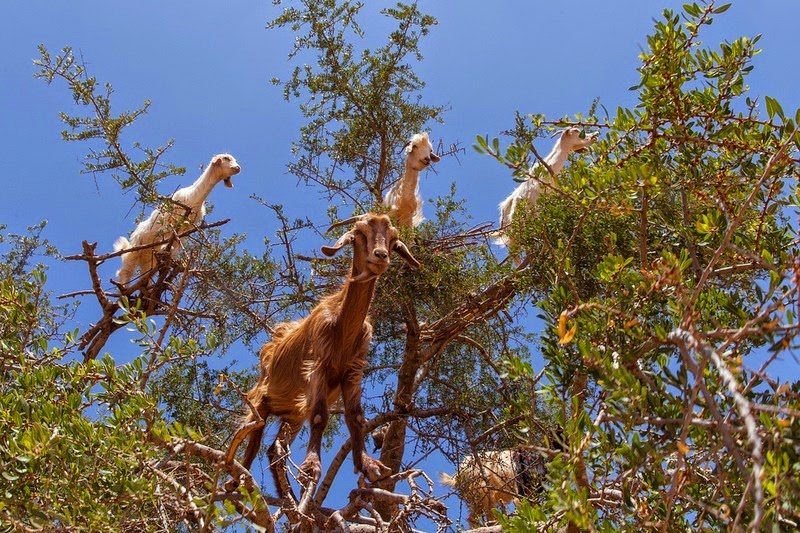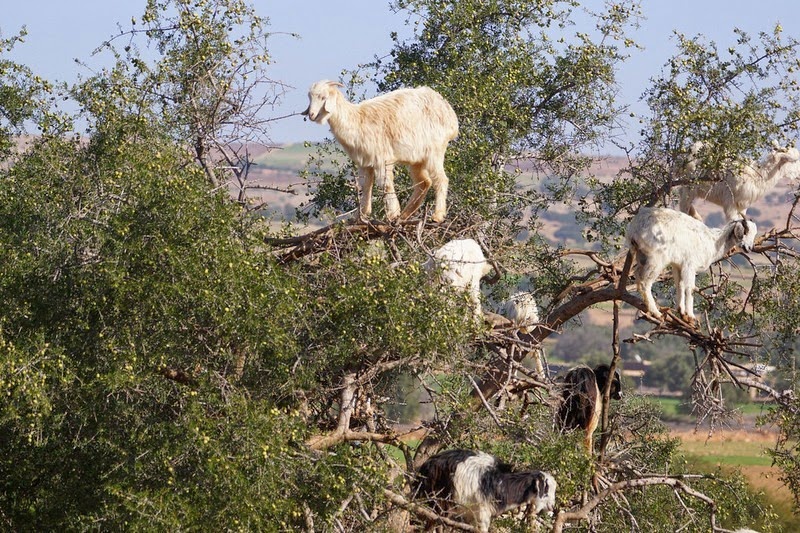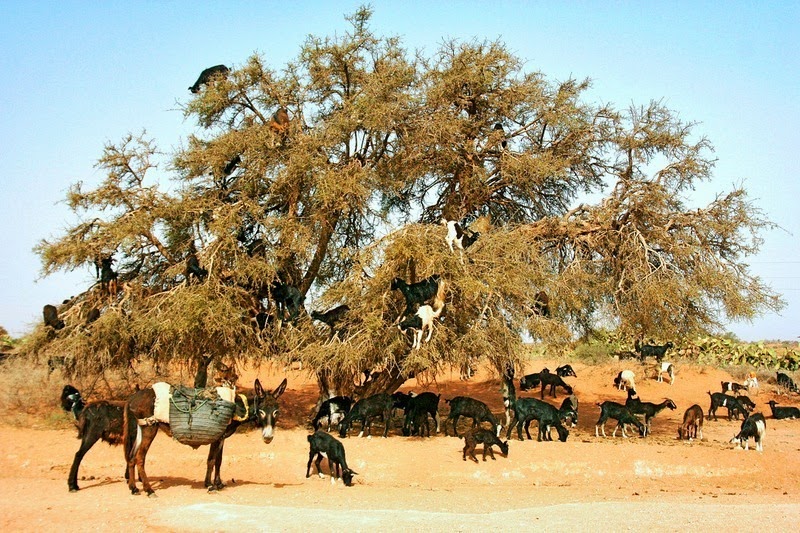Tree Climbing Goats of Morocco | Amazing Images.
In southwest Morocco, you might actually be forgiven for asking daft
questions like “do goats grow on trees?”. Everywhere you look, you will
find dozens of goats hanging out lazily from the tree tops, munching
absentmindedly like overgrown crows. Goats are skilled climbers
and are known to scale steep rock faces and mountains in search of
food. The ones in Morocco climb trees for the same reason – food, which
is otherwise scarce in this drought-ridden region. The goats are drawn
to the fruit of the Argan tree, which ripens in June each year. The
Argan grows to 8-10 meters high and live up to 150–200 years. They are
thorny, with gnarled trunks, but the goats, who have been climbing these
trees for centuries, have learnt to adapt themselves to the task. 
Photo credit
The goats native to this region have cloven feet. Each hoof has two toes which can spread out, providing balance and leverage, while the soles of their feet are soft and yielding, helping them to grip the bark. The animals also have two vestigial toes higher up their legs, called dewclaws. These are found on many species including cats and dogs, but the goats’ dewclaws are much firmer and stubbier and help the creatures pull themselves up branches, or lower themselves down sheer cliff faces.
The Argan is endemic to the semi-desert Sous valley of southwestern Morocco and to the Algerian region of Tindouf in the western Mediterranean region. The fruit is also a valuable source of oil, and an important source of economy for the Berber people of Morocco. The fruit, which is about 2–4 cm long, has a very hard nut surrounded by the fleshy part that the goats eat. Inside the nut contains one or two, small, oil-rich seeds. The fruit takes over a year to mature, ripening in June to July of the following year. Until this happens, the goats are kept out of the Argan woodlands, because the animals would often eat the fruit before it’s ripe, as well as the leaves stunting the growth of the trees.

Photo credit
Traditionally, the goats were a part of the oil producing business. The local Berber people would allow the goats to eat the fruit, but the hard nut would pass through the animal’s digestive system unharmed. The goat excrete would then be collected, the seeds removed and grinded or pressed to extract oil, which is used in salad dressing and cosmetics. Removing the soft pulp is the most labor-intensive part of the oil-extraction process which is why the goats were employed. Modern methods, however, have bypassed this stage because a “goaty” smell can sometimes be detected in the oil.
During the past two decades, argan oil has soared in popularity and price to become the world's most expensive oil (about $300/liter). It is sold in Europe and North America where it has become a fashionable product.
Ironically, the argan oil’s popularity has threatened the very survival of this tree. The extra cash acquired from selling the oil has enabled the locals to buy more goats, resulting in more climbing and damage to the trees. Trees are also felled for their wood or to make way for other crops. Through the 1970s and 1980s about 600 hectares of argan forest per annum was lost.

Photo credit

Photo credit

Photo credit

Photo credit

The argan fruit. Photo credit

Grinding argan seeds into a paste. Photo credit

Women sorting argan seeds. Photo credit
Sources: Financial Times / Daily Mail / Discovery / Wikipedia

Photo credit
The goats native to this region have cloven feet. Each hoof has two toes which can spread out, providing balance and leverage, while the soles of their feet are soft and yielding, helping them to grip the bark. The animals also have two vestigial toes higher up their legs, called dewclaws. These are found on many species including cats and dogs, but the goats’ dewclaws are much firmer and stubbier and help the creatures pull themselves up branches, or lower themselves down sheer cliff faces.
The Argan is endemic to the semi-desert Sous valley of southwestern Morocco and to the Algerian region of Tindouf in the western Mediterranean region. The fruit is also a valuable source of oil, and an important source of economy for the Berber people of Morocco. The fruit, which is about 2–4 cm long, has a very hard nut surrounded by the fleshy part that the goats eat. Inside the nut contains one or two, small, oil-rich seeds. The fruit takes over a year to mature, ripening in June to July of the following year. Until this happens, the goats are kept out of the Argan woodlands, because the animals would often eat the fruit before it’s ripe, as well as the leaves stunting the growth of the trees.

Photo credit
Traditionally, the goats were a part of the oil producing business. The local Berber people would allow the goats to eat the fruit, but the hard nut would pass through the animal’s digestive system unharmed. The goat excrete would then be collected, the seeds removed and grinded or pressed to extract oil, which is used in salad dressing and cosmetics. Removing the soft pulp is the most labor-intensive part of the oil-extraction process which is why the goats were employed. Modern methods, however, have bypassed this stage because a “goaty” smell can sometimes be detected in the oil.
During the past two decades, argan oil has soared in popularity and price to become the world's most expensive oil (about $300/liter). It is sold in Europe and North America where it has become a fashionable product.
Ironically, the argan oil’s popularity has threatened the very survival of this tree. The extra cash acquired from selling the oil has enabled the locals to buy more goats, resulting in more climbing and damage to the trees. Trees are also felled for their wood or to make way for other crops. Through the 1970s and 1980s about 600 hectares of argan forest per annum was lost.

Photo credit

Photo credit

Photo credit

Photo credit

The argan fruit. Photo credit

Grinding argan seeds into a paste. Photo credit

Women sorting argan seeds. Photo credit
Sources: Financial Times / Daily Mail / Discovery / Wikipedia